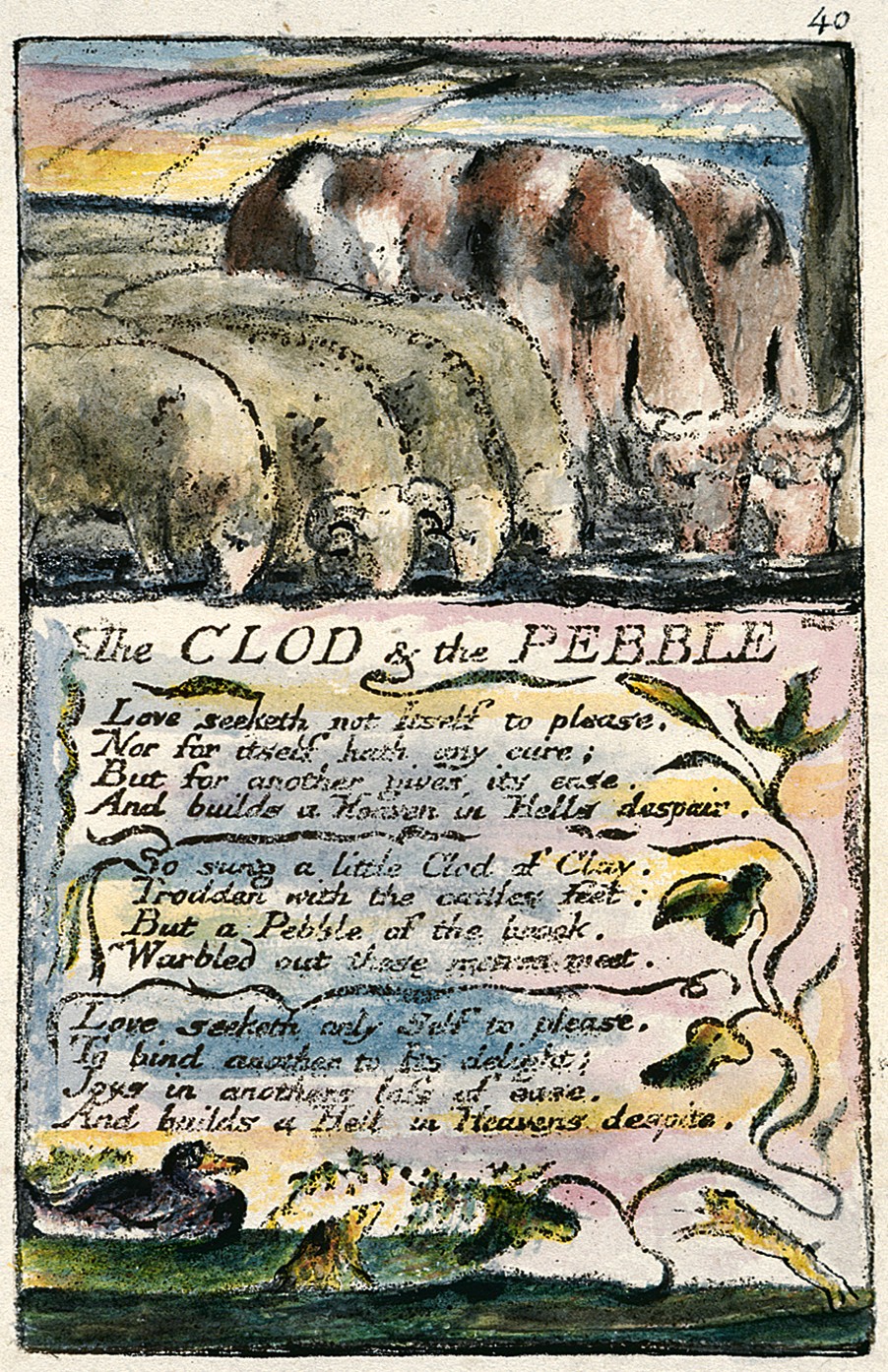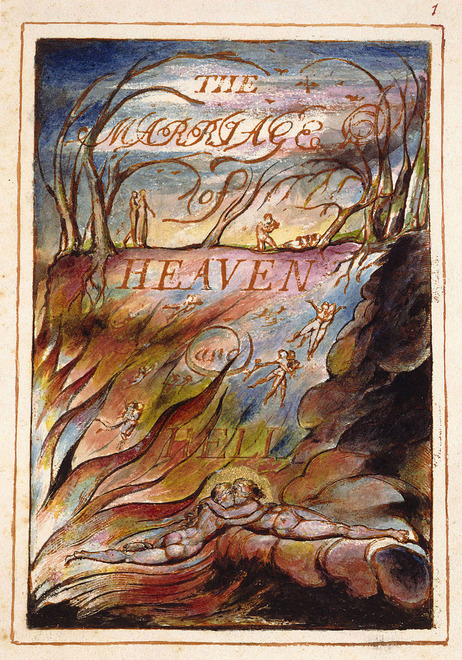British Museum
Small Book of Designs
Marriage of Heaven and Hell, Plate14
"A Flaming Sword/Revolving every way"
Marriage of Heaven and Hell, Plate 4, (E 34) "The voice of the Devil
All Bibles or sacred codes. have been the causes of the
following Errors.
1. That Man has two real existing principles Viz: a Body & a Soul.
2. That Energy. calld Evil. is alone from the Body. & that
Reason. calld Good. is alone from the Soul.
3. That God will torment Man in Eternity for following his
Energies.
But the following Contraries to these are True
1 Man has no Body distinct from his Soul for that calld Body is
a portion of Soul discernd by the five Senses. the chief inlets
of Soul in this age
2. Energy is the only life and is from the Body and Reason is
the bound or outward circumference of Energy.
3 Energy is Eternal Delight"
Marriage of Heaven and Hell, Plate 14, (E 39)"But first the notion that man has a body distinct from his soul, is to be expunged; this I shall do, by printing in the infernal method, by corrosives, which in Hell are salutary and medicinal, melting apparent surfaces away, and displaying the infinite which was hid."America, Plate 6, (E 53)"Let the slave grinding at the mill, run out into the field: Let him look up into the heavens & laugh in the bright air; Let the inchained soul shut up in darkness and in sighing, Whose face has never seen a smile in thirty weary years; Rise and look out, his chains are loose, his dungeon doors are open. And let his wife and children return from the opressors scourge; They look behind at every step & believe it is a dream. Singing. The Sun has left his blackness, & has found a fresher morning And the fair Moon rejoices in the clear & cloudless night; For Empire is no more, and now the Lion & Wolf shall cease."Milton, Plate 14 [15], (E 108)"O when Lord Jesus wilt thou come? Tarry no longer; for my soul lies at the gates of death. I will arise and look forth for the morning of the grave. I will go down to the sepulcher to see if morning breaks! I will go down to self annihilation and eternal death, Lest the Last Judgment come & find me unannihilate And I be siez'd & giv'n into the hands of my own Selfhood"Jerusalem, Plate 71, (E 224)"And above Albions Land was seen the Heavenly Canaan As the Substance is to the Shadow: and above Albions Twelve Sons Were seen Jerusalems Sons: and all the Twelve Tribes spreading Over Albion. As the Soul is to the Body, so Jerusalems Sons, Are to the Sons of Albion: and Jerusalem is Albions Emanation What is Above is Within, for every-thing in Eternity is translucent: The Circumference is Within: Without, is formed the Selfish Center And the Circumference still expands going forward to Eternity. And the Center has Eternal States! these States we now explore."Auguries of innocence, (E 429)"We are led to Believe a Lie When we see not Thro the Eye"Laocoon, (E 273)
"Adam is only The Natural Man & not the Soul or Imagination
The Eternal Body of Man is The IMAGINATION."Four Zoas, Night VII, Page 86, (E 368)"Los furious answerd. Spectre horrible thy words astound my Ear
With irresistible conviction I feel I am not one of those
Who when convincd can still persist. tho furious.controllable
By Reasons power. Even I already feel a World within
Opening its gates & in it all the real substances
Of which these in the outward World are shadows which pass away
Come then into my Bosom & in thy shadowy arms bring with thee
My lovely Enitharmon. I will quell my fury & teach
Peace to the Soul of dark revenge & repentance to Cruelty
So spoke Los & Embracing Enitharmon & the Spectre
Clouds would have folded round in Extacy & Love uniting
PAGE 87
But Enitharmon trembling fled & hid beneath Urizens tree
But mingling together with his Spectre the Spectre of Urthona
Wondering beheld the Center opend by Divine Mercy inspired
He in his turn Gave Tasks to Los Enormous to destroy
That body he created but in vain for Los performd Wonders of labour
They Builded Golgonooza Los labouring builded pillars high
And Domes terrific in the nether heavens for beneath
Was opend new heavens & a new Earth beneath & within
Threefold within the brain within the heart within the loins
A Threefold Atmosphere Sublime continuous from Urthonas world
But yet having a Limit Twofold named Satan & Adam" Blake asks us to discern not define. What can we discern in this image and in these passages concerning the soul?It may seem that the upper figure is the soul and the lower figure is the body. But it appears that the upper figure discrens the lower figure, and not the other way around. Blake states "that calld Body is a portion of Soul discernd by the five Senses." In the image the soul figure appears to discern the sleeping body, perhaps by "melting apparent surfaces away, and displaying the infinite which was hid." It is the lower figure, apparently sleeping, who needs to "Rise and look out," perhaps he is the "inchained soul shut up in darkness." But how should this be accomplished other than by "self annihilation and eternal death."If we see the image with our natural eye, we see not that 'What is Above is Within, for every-thing in Eternity is translucent." Seeing "thro" the eye we discern that "The Eternal Body of Man is The IMAGINATION." Like Los we must "quell [our] fury & teach Peace to the Soul of dark revenge & repentance to Cruelty" so that we may see "new heavens & a new Earth beneath & within" opening even in this life.








